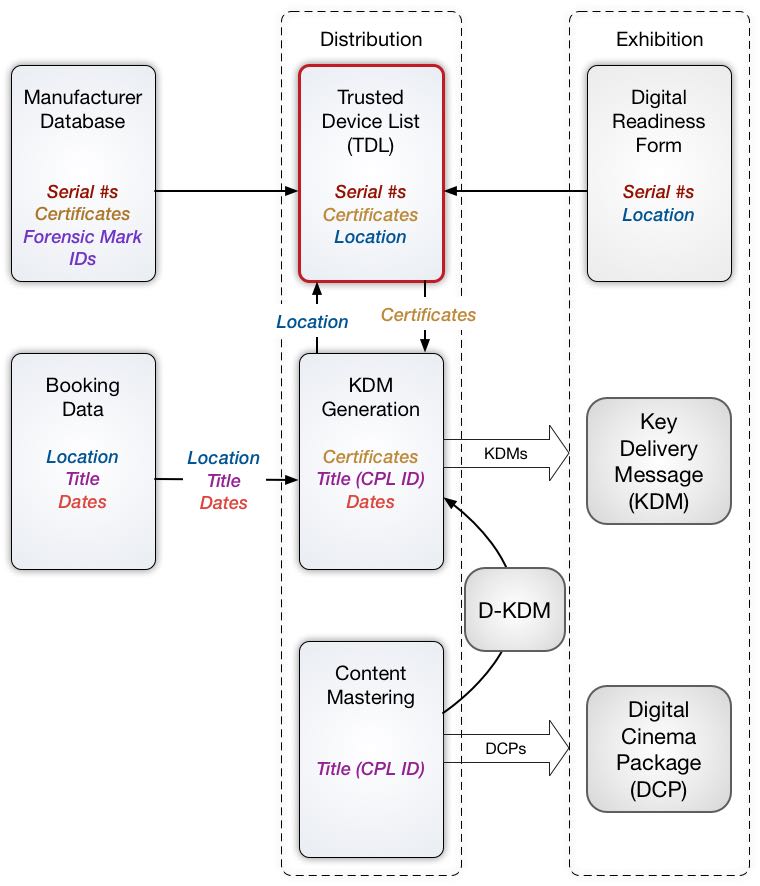
The Trusted Device List, or TDL, plays an important role in the management of content security, and the distribution of content. Not only does it track the location of trusted devices in the field, but it also tracks the databases of trusted devices from manufacturers. Notably, more than one TDL exists, with each TDL often managed by a private entity engaged in some stage of content distribution. In the distribution workflow, metadata from several sources must be gathered and matched to properly enable the exhibition of content per the booking commitments of the content owner. The TDL plays an important role in this process.
To best understand the purpose of a TDL, an illustration of metadata workflow in distribution is presented below.

Trusted Device List & Metadata Workflow
Trusted Device List (TDL). A TDL is a database of equipment and security-related information, collected from both equipment manufacturers and exhibitors. The database is maintained by studios and/or trusted fulfillment entities. At a minimum, the database marries manufacturer public-key certificates and serial numbers with serial number and location information received from exhibitors. TDLs are used by fulfillment entities when generating KDMs. If the TDL database is not up-to-date, the movie may not play.
Manufacturer Database. A database of product security-related information maintained by manufacturers, as required by Digital Cinema Initiatives (DCI). DCI requires the database to carry media block serial numbers, public-key certificates, and forensic mark identifiers. Manufacturer databases are utilized by TDLs.
Digital Readiness Form. An ad hoc form for collecting information regarding the DCI-compliant playback equipment operated at a site. Such forms can be quite detailed, designed to tailor content versions to the particular needs of each screen at the site. At a minimum, media block serial numbers, screen numbers, and the location of the cinema are sent by the exhibitor to the TDL owner. It is incumbent on exhibitors to keep the TDL up-to-date for movies to play. [Note: modern systems replace the Digital Readiness Form with the machine-generated Extended Facility List Message (SMPTE ST 430-16) exchanged with the TDL operator using the FLM-x (SMPTE ST 430-15) protocol.]
Booking Data. Business data that comprises the movie booking. Movie engagements are booked with exhibitors long before the movie itself has completed post production. As a result, booking data typically consists of movie titles, dates of engagement, and location, but not data-centric information such as a CPL identifier for the title.
KDM Generation. When generating KDMs, information from multiple sources must be collected and matched. Location and dates of engagement must be obtained from the Booking Data. The booking location is then used to pull the appropriate media block public-key certificates from the TDL. D-KDMs must be collected from Content Mastering for the title. When the appropriate information is collected and matched, KDMs for an exhibition site can be generated. Note that if TDL entries do not exist or are possibly out-of-date, the exhibitor may be requested to submit a new Digital Readiness Form to the TDL owner.
Content Mastering. Composition Track Files are encrypted at the content mastering stage, resulting in the creation of a D-KDM. The D-KDM is used by the KDM Generator to generate exhibition-directed KDMs. By nature of a KDM, the D-KDM carries the Composition Identifier (CPL ID) used to match a KDM with its Composition.